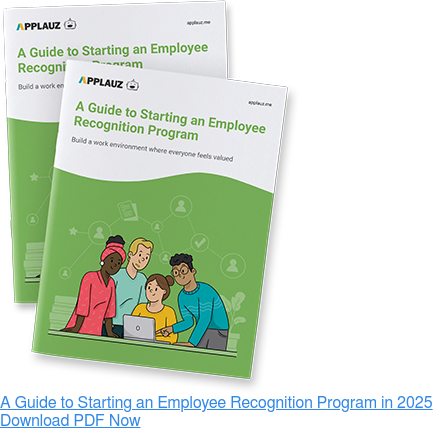Yes, it’s true: the days of annual performance reviews and generic 'Employee of the Month' plaques are over. Today's workforce expects recognition that's as dynamic and personalized as they are.
This year, the most successful companies aren’t just handing out generic praise; they’re leveraging data, emerging tech, and cultural insights to make employee appreciation more authentic and backed by deeper meaning for a bigger impact.
Read on to learn how this year’s top five recognition trends are reshaping how businesses celebrate their teams.
Top 5 Key Employee Recognition Trends

Employee recognition programs aren’t just a “nice-to-have” — they directly influence engagement, retention, and business performance.
A recent BetterUp study found that feelings of belonging in the workplace lead to a 56% increase in job performance, a 50% reduction in turnover risk, and a 75% decrease in employee sick days.
With these numbers, you’d expect every organization to be on the lookout for employee recognition trends. Yet, many companies still rely on outdated methods that fail to inspire employees or align with evolving workplace expectations.
Read on to learn how this year’s top five recognition trends drive both employee satisfaction and organizational success.
1. Data-Driven Recognition
While employee recognition has always been a workplace priority, what’s evolving is the wealth of data available to refine and enhance how it’s implemented.
Emerging tech trends really are fueling data-driven recognition as a pivotal trend in employee engagement strategies. Let’s explore.
AI-Powered Recognition Insights
Organizations can better interpret employee engagement rates by leveraging data mined from emerging technologies like AI, which fuel more timely and personalized employee recognition.
One significant advancement is the use of AI-powered recognition suggestions. These systems analyze employee performance data to recommend personalized recognition approaches, so praise is unique to each employee.
This tailored approach can greatly benefit large organizations, saving time while boosting individual morale and aligning employee recognition with organizational goals.
By using AI to analyze performance metrics quickly, organizations can identify top performers and tailor recognition programs accordingly.
For example, a sales company can use data to highlight employees who consistently exceed KPIs and then target their recognition efforts to ensure this employee segment receives timely and relevant feedback on their accomplishments.
Predictive Analytics for Stronger Engagement
The data provided by predictive analytics is another big game changer for companies as it helps to identify patterns that may indicate declining employee satisfaction or potential turnover risks.
Companies can then use this data to proactively address issues, like low engagement ratings or high turnover risk, and implement targeted recognition initiatives to re-engage employees at risk of a high turnover rate.
Using Data to Measure ROI for Employee Recognition Programs
Data collection also helps companies measure the ROI of their recognition programs, which is crucial for demonstrating value.
As an example, imagine your company establishes a standardized framework to measure AI ROI. This framework includes defining clear objectives, selecting relevant KPIs, and reviewing regularly. Executives can then use these metrics to monitor the success of AI projects.
Incorporating data-driven recognition strategies enables organizations to create a culture of appreciation that is both strategic and impactful.
By leveraging AI-powered tools and analytics, companies can make recognition more meaningful, timely, and strategically aligned with business goals—driving higher engagement and performance.
2. Tech-Enhanced Recognition
Leveraging emerging technologies like AI and smart integrations continues to be one of the most popular employee recognition trends.
The following tools are designed to make employee recognition more engaging, personalized, and seamlessly integrated into daily workflows.
AI-Powered Recognition Platforms
Instead of generic praise, AI helps managers and peers quickly highlight specific achievements, recognize performance, reward achievements, and, ultimately, retain excellence.
Employee recognition platforms, like Applauz, take the guesswork out of recognition by analyzing performance data to suggest meaningful and timely acknowledgments.
Powerful Integrations
Powerful integrations with popular third-party productivity tools — like Slack, Asana, Microsoft Teams, Amazon Marketplace, and more — make the entire employee recognition and rewards process even more effortless.
By using third-party platforms that your employees are already well-acquainted with, it’ll be all the more easy for your team to adopt the new approach to recognition. In this way, companies can help eliminate any unnecessary friction and encourage real-time appreciation.
3. Cross-Cultural Recognition
As workplaces become more global, a one-size-fits-all approach no longer works.
With a distributed workforce comes new challenges – companies need cross-cultural recognition programs that adapt to diverse cultural expectations and values.
Global Team Appreciation Strategies
We often overlook the small, everyday moments of peer-to-peer appreciation in the office — like a friendly “good morning,” a quick thank-you in passing, or a simple compliment on someone's demeanor.
But how do you cultivate a culture where these moments of recognition become second nature?
One of the best ways to simulate this recognition style on a global scale is through peer-to-peer recognition programs.
Several employee recognition software, like Applauz, simplify the peer-to-peer recognition process by allowing employees from different regions to recognize each other's achievements from one universal space.
Cultural Sensitivity
Cultural sensitivity should not be ignored, especially when recognizing employees on a global scale. For example, some cultures may appreciate group-based rewards versus individual performance-based rewards.
Such is the case when examining how rewards and organizational performance compare between Japanese and U.S. companies.
One report found that Japanese organizations emphasize group-based rewards, reflecting their collectivist culture. U.S. companies, on the other hand, tend to focus on individual performance-based rewards, aligning with a more individualistic cultural orientation.
Employee motivation and job satisfaction are closely linked to how well an employee recognition program aligns with cultural expectations. For this reason, it's imperative that organization leaders and HR professionals consider cultural values when designing a global recognition and rewards system. Listen to and learn from your employees!
Localized Reward Preferences
If employee recognition on a global scale is a challenge for your company, go the extra mile and start by implementing a region-specific rewards program.
One example is to provide more localized rewards — versus a generic gift card reward, for example — like extra paid leave for European employees or wellness stipends for teams in Asia.
This tailored approach shows your employees that you take their unique needs seriously. It also demonstrates that recognition isn’t just a policy — it’s a genuine effort to celebrate employees in a way that matters to them.
Organizations can foster stronger connections, increase employee engagement, and create a truly inclusive workplace by embracing a cross-cultural recognition approach.
4. Mental Health-Focused Recognition
If you want to see your employee engagement rates skyrocket, mental health-focused employee recognition is the approach you want to take. By taking a mental health-focused approach, you’re sending your employees a powerful message that their mental health matters.
If we lived in a Mad Men workplace era, setting healthy boundaries — like logging off on time or encouraging mindful breaks — would be cause for dismissal. In a post-pandemic era, companies who want to really show their employees that they are valued should be rewarding employees for these boundaries.
A mental health-focused recognition approach can take many forms. For example, companies can offer wellness stipends, fitness subsidies, healthy meal deliveries, extra days off, and more.
Encouraging Peer Recognition Programs
Peer recognition programs highlight acts of kindness, such as helping a colleague manage workload stress or checking in on a teammate experiencing a difficult time. For this reason, employees who support one another make up the heart of a mental health-focused recognition strategy.
Employee recognition software often includes peer-to-peer recognition features. For example, Applauz offers a digital Badge feature, allowing managers and employees to reward colleagues with personalized badges — like the Helping Hand badge — to publicly show appreciation.
Integrating mental health-focused recognition can be one of the most rewarding approaches to recognition programs because it builds a culture where employees feel genuinely valued, not just for what they achieve, but for how they contribute to the team dynamic as a real human being.
5. Skills-Based Recognition
Work should be about more than just a paycheck — it should be about growth. That’s one big reason why skills-based recognition is trending this year.
Organizations are shifting from traditional tenure-based rewards to celebrating continuous learning, peer-driven endorsements, and career development achievements.
Whether completing a certification, mastering a new software, or finishing an internal training program, companies now celebrate these learning milestones with shout-outs, digital badges, leadership and mentor opportunities, and more.
Peer Skill Endorsements
Encouraging employees to endorse each other's skills fosters a culture of mutual recognition and respect. Not to mention the numerous other benefits of peer-to-peer recognition like:
- Creating a continuous culture of giving
- Improving transparency
- Lowering dependence on management
- Promoting organizational values
- Creating a collaborative culture
The Incentive Research Foundation found that peer-to-peer appreciation, amongst millennials in particular, was actually the preferred choice of being appreciated. Many companies are taking note.
For example, social platforms like LinkedIn facilitate peer-to-peer recognition by allowing colleagues to validate each other's competencies through skill endorsements and written recommendations. Not only does this enhance professional credibility and help employees advance their careers, but it also strengthens team dynamics.
Career Development Recognition
Instead of only rewarding end results, companies have the opportunity to highlight progress — whether it's a junior employee leading their first project, someone pivoting into a new role, or receiving recognition points for mentoring, the goal here is to create a culture where learning is valued at all levels. By recognizing effort, not just outcome, you promote your employees’ determination, innovation, and hard work.
By embracing skills-based recognition, organizations inspire employees to keep growing, which in turn improves retention, and builds a more capable, future-ready workforce.
Turn Trends into Action: How To Implement an Employee Recognition Strategy

For a successful employee recognition strategy, you’ve got to go beyond occasional praise. Consistency is key, here, as it builds trust and gathers the momentum for truly effective employee recognition. The best recognition strategies are continuous and require a structured approach to budgeting, feedback, and measurement.
Here’s how companies can implement recognition programs that are both impactful and sustainable.
1. Smart Budget Allocation
Investing in employee recognition doesn’t have to break the bank. Companies use models like fixed budgets per employee, performance-based incentives, or peer-nominated rewards to maximize impact. The key is aligning recognition spending with company goals while ensuring every employee feels valued.
2. Employee-Driven Recognition Programs
The best recognition programs evolve with employee feedback. Regular pulse surveys, focus groups, and employee engagement analytics help fine-tune initiatives. Employees know what best motivates them, so integrating their insights will only make recognizing employees more meaningful and effective.
3. Measuring Success
Recognition isn't just a feel-good initiative; it has the power to drive real results. The most successful companies track success using engagement scores, retention rates, and productivity metrics. If your recognition efforts don’t move the needle, you can use these measurements to make adjustments to improve the effectiveness of your recognition program.
If you want to gain even more inspiration for your next initiative, check out this Applauz guide to target recognition ideas for your industry.
What’s Next for Employee Recognition?

As we said previously, employee recognition is shifting beyond occasional rewards toward a more strategic and continuous approach. To stay ahead, organizations must leverage data, technology, and personalization to make recognition more meaningful and impactful.
As AI-driven insights, cultural inclusivity, and skills-based recognition gain traction, companies that adapt will see higher engagement, retention, and productivity. To stay on top of trends, businesses should assess their current recognition strategies and integrate modern tools that align with employee expectations.
Smart businesses use supportive tools, like employee recognition platforms such as Applauz, to streamline employee recognition programs and provide data-driven insights to optimize impact. Employee recognition doesn’t have to be a huge undertaking, thanks to technology.
Prioritizing frequent, personalized recognition ensures that appreciation becomes an ingrained part of company culture—not just an afterthought.
Recognition goes beyond rewarding achievements — it’s about creating a workplace where employees feel valued every day. By acting now, your organization can cultivate a culture of appreciation that drives a successful, connected workforce.
Boost employee engagement with meaningful recognition — try Applauz today!
About the author
Becky Lynn
Becky Lynn is a freelance writer who aims to make HR strategies and employee engagement practices accessible and relatable for entrepreneurs and professionals alike.




